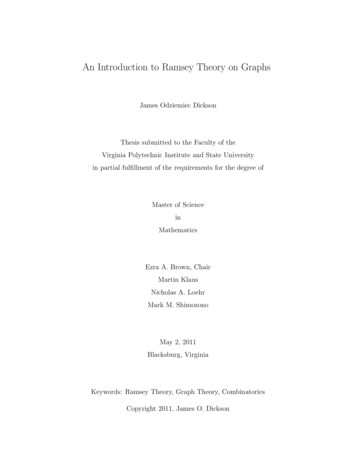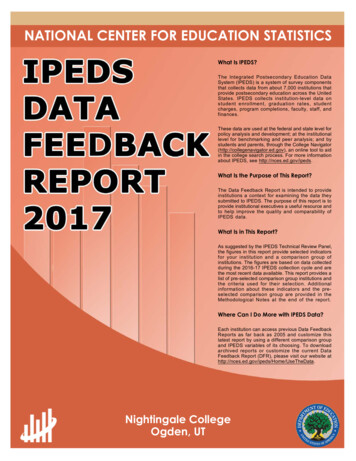
Transcription
An Introduction to Ramsey Theory on GraphsJames Odziemiec DicksonThesis submitted to the Faculty of theVirginia Polytechnic Institute and State Universityin partial fulfillment of the requirements for the degree ofMaster of ScienceinMathematicsEzra A. Brown, ChairMartin KlausNicholas A. LoehrMark M. ShimozonoMay 2, 2011Blacksburg, VirginiaKeywords: Ramsey Theory, Graph Theory, CombinatoricsCopyright 2011, James O. Dickson
An Introduction to Ramsey Theory on GraphsJames O. Dickson(ABSTRACT)Ramsey theory deals with finding order amongst apparent chaos. Given a mathematicalstructure of interest and a setting where it may appear, Ramsey theory strives to identifyconditions on this setting under which our mathematical structure of interest must appear.On a clear night one can look into the sky and observe patterns amongst the stars. Supposewe are interested in finding a constellation of 10 stars forming a cup shape. Are we guaranteedto find this constellation if we can see 100 stars, 1000 stars, or infinitely many stars? Themathematical generalization of this question has been named the Happy End problem afterits proposer and solver, Esther Kline and George Szekeres who married shortly after solvingit (the role of the proposer being reversed!). At the time Esther and George’s mathematicscircle included Paul Erdos who became the most prolific mathematical author ever and theleading exponent of Ramsey theory. When Erdos lectured about Ramsey theory on graphshe drew in his audience with two problems. The first problem has been named the Partyproblem. Given 6 people who have been invited to a party can we always find a subset of3 people all of whom know each other or all of who do not know each other? The problemis equivalent to asking if every coloring of the edges of the complete graph on 6 vertices inthe colors maroon and orange contains a subgraph of 3 vertices for which the edges runningbetween these vertices are either all maroon or all orange. The least number of vertices onwhich the complete graph on these vertices guarantees such a set of 3 vertices is denotedR(3,3). Ramsey type problems typically include some form of partitioning. In the aboveexample we partitioned the pairs of invitees into 2 sets, those pairs who knew each other andthose pairs that did not. Then we asked if we could find 3 pairs in either of the partitionswith the property that they formed a triangle of 3 people. In a typical Ramsey problem wenot only insist that our object of interest appear as a substructure of some superstructure, weask: how large must our superstructure be so that no matter how we partition it into a given
number of parts, one of the partitions contains the desired substructure? Erdos’s secondproblem asks us to pretend we have encountered aliens who will destroy us unless we can tellthem R(5,5), what should we do, what if they asked for R(6,6)? For R(5,5) Erdos says thatall mathematicians and computers should work together to find the solution. For R(6,6)Erdos recommends trying to figure out a way to destroy the aliens before they destroy us!It has been shown that R(6,6) is at least 102. Before considering symmetries there are 2102or more than 1030 graphs on 102 vertices. The number of atoms in the observable universeis estimated as less than 1080 . The computational power required to obtain R(6,6) by bruteforce may never be available, the upper bound of 165 requires checking nearly 1050 graphs.It is fascinating that we even have upper bounds given our computational shortcomings.But even more fascinating is that Ramsey theory gives us upper bounds for R(m,n) for anynatural numbers m and n. It is these techniques that drew me to this topic and which I hopeto relate. All sorts of mathematical weaponry have been brought to bear on Ramsey theory:constructive methods, computer algorithms, random graphs and the probabilistic method.Despite the difficulty of classical Ramsey theory the beauty of the philosophy behind it hasled mathematicians to other elegant areas: Euclidean Ramsey theory, the problem of thechromatic number of the plane, Schur’s theorem, van Der Waerden’s theorem, the HalesJewett theorem, and other results in extremal graph theory are critical parts in the growingRamsey theory.iii
DedicationThis work is firstly dedicated to my little brother Will. Your potential is unbounded. Tomy twin sister Sara, I would not be where I am today if I had not grown up along sideyou. To my mother Camille and father John, your dedication to family is inspiring. Mygrandmother, Nana, your positive influence has been ever present. I love you guys.iv
AcknowledgmentsI wish to acknowledge Dr. Ezra Brown for his patience, guidance, and support withoutwhich this thesis could not have been written. Bud’s mentoring and sage advice is invaluable.Thank you B2 !I also wish to acknowledge the useful corrections and encouragement I received from mycommittee members: Martin Klaus, Nick Loehr, and Mark Shimozono.Thanks to the Math Department of Virginia Tech for the support, financial and otherwise.Andrew Wills and Maria Beane your compatriotism, assistance, and advice have made thisprocess not only bearable but fun.Michael Stewart and Jennifer Pavlak your friendship has been awesome during my time atVirginia Tech.Laurie Heyer, Sarah Mason, Tim Chartier, Irl Bivens, Rich Niedinger, John Swallow, andRobert Whitton from Davidson College’s math department: your passion for math inspiredme to pursue graduate school.v
Contents1 Introduction11.1Introduction . . . . . . . . . . . . . . . . . . . . . . . . . . . . . . . . . . . .11.2Preliminaries . . . . . . . . . . . . . . . . . . . . . . . . . . . . . . . . . . .31.3Frank P. Ramsey . . . . . . . . . . . . . . . . . . . . . . . . . . . . . . . . .41.4Ramsey’s Theorem . . . . . . . . . . . . . . . . . . . . . . . . . . . . . . . .71.5Generalized and Infinite versions of Ramsey’s Theorem . . . . . . . . . . . .111.5.1More Colors . . . . . . . . . . . . . . . . . . . . . . . . . . . . . . . .111.5.2Arbitrary Graphs . . . . . . . . . . . . . . . . . . . . . . . . . . . . .121.5.3Hypergraphs . . . . . . . . . . . . . . . . . . . . . . . . . . . . . . . .131.5.4Infinite version of Ramsey’s theorem . . . . . . . . . . . . . . . . . .131.5.5Compactness . . . . . . . . . . . . . . . . . . . . . . . . . . . . . . .151.5.6Density . . . . . . . . . . . . . . . . . . . . . . . . . . . . . . . . . .151.5.7Compactness Continued . . . . . . . . . . . . . . . . . . . . . . . . .18Paul Erdős . . . . . . . . . . . . . . . . . . . . . . . . . . . . . . . . . . . . .201.62 Ramsey Numbers24vi
2.1Exact Values . . . . . . . . . . . . . . . . . . . . . . . . . . . . . . . . . . .242.2Erdős’ lower bound . . . . . . . . . . . . . . . . . . . . . . . . . . . . . . . .342.3Lovasz Local Lemma . . . . . . . . . . . . . . . . . . . . . . . . . . . . . . .352.4Diagonal Ramsey numbers . . . . . . . . . . . . . . . . . . . . . . . . . . . .372.5A recursive upper bound for diagonal Ramsey numbers . . . . . . . . . . . .392.6Comparing near diagonal Ramsey numbers . . . . . . . . . . . . . . . . . . .412.7R(3, k) . . . . . . . . . . . . . . . . . . . . . . . . . . . . . . . . . . . . . . .432.8Combinatorial Games and Ramsey Numbers . . . . . . . . . . . . . . . . . .463 Chromatic number of the plane523.1Vertex Coloring . . . . . . . . . . . . . . . . . . . . . . . . . . . . . . . . . .523.2Coloring the plane . . . . . . . . . . . . . . . . . . . . . . . . . . . . . . . .543.3Generalizations of the chromatic number of the plane . . . . . . . . . . . . .604 Ramsey-type theorems for the Integers644.1Schur’s theorem . . . . . . . . . . . . . . . . . . . . . . . . . . . . . . . . . .644.2Van der Waerden’s theorem . . . . . . . . . . . . . . . . . . . . . . . . . . .694.3Rado’s theorem . . . . . . . . . . . . . . . . . . . . . . . . . . . . . . . . . .724.4Hilbert’s Cube Lemma . . . . . . . . . . . . . . . . . . . . . . . . . . . . . .744.5The happy end problem . . . . . . . . . . . . . . . . . . . . . . . . . . . . .754.6Conclusion . . . . . . . . . . . . . . . . . . . . . . . . . . . . . . . . . . . . .76Bibliography77vii
List of Figures1.1R(3, 3) 5 . . . . . . . . . . . . . . . . . . . . . . . . . . . . . . . . . . . . .72.1R(3, 4) 8. . . . . . . . . . . . . . . . . . . . . . . . . . . . . . . . . . . . .252.2R(3, 5) 13. . . . . . . . . . . . . . . . . . . . . . . . . . . . . . . . . . . . .262.3R(4, 4) 17. . . . . . . . . . . . . . . . . . . . . . . . . . . . . . . . . . . . .272.4R(3, 3, 3) 16 . . . . . . . . . . . . . . . . . . . . . . . . . . . . . . . . . . .513.1Moser’s Spindle . . . . . . . . . . . . . . . . . . . . . . . . . . . . . . . . . .563.2Golomb graph . . . . . . . . . . . . . . . . . . . . . . . . . . . . . . . . . . .573.3Square tiling . . . . . . . . . . . . . . . . . . . . . . . . . . . . . . . . . . . .573.4Hexagon tiling . . . . . . . . . . . . . . . . . . . . . . . . . . . . . . . . . . .583.5Stechkin’s example . . . . . . . . . . . . . . . . . . . . . . . . . . . . . . . .61viii
Chapter 1Introduction1.1IntroductionRamsey theory deals with finding order amongst apparent chaos. Given a mathematicalstructure of interest and a setting where it may appear, Ramsey theory strives to identifyconditions on this setting under which our mathematical structure of interest must appear.On a clear night one can look into the sky and observe patterns amongst the stars. Supposewe are interested in finding a constellation of 10 stars forming a cup shape. Are we guaranteedto find this constellation if we can see 100 stars, 1000 stars, or infinitely many stars? Themathematical generalization of this question has been named the Happy End problem afterits proposer and solver, Esther Kline and George Szekeres who married shortly after solvingit (the role of the proposer being reversed!). At the time Esther and George’s mathematicscircle included Paul Erdős, who became the most prolific mathematical author ever and theleading proponent of Ramsey theory.When Erdős lectured about Ramsey theory on graphs he drew in his audience with twoproblems. The first problem has been named the Party problem. Given 6 people who havebeen invited to a party, can we always find a subset of 3 people all of whom know each other1
James O. DicksonChapter 1. Introduction2or all of whom do not know each other? The problem is equivalent to asking if every coloringof the edges of the complete graph on 6 vertices in the colors maroon and orange containsa subgraph of 3 vertices for which the edges running between these vertices are either allmaroon or all orange. The least number of vertices on which the complete graph on thesevertices guarantees such a set of 3 vertices is denoted R(3,3).Ramsey-type problems typically include some form of partitioning. In the above examplewe partitioned the pairs of invitees into 2 sets, those pairs who knew each other and thosepairs that did not. Then we asked if we could find 3 pairs in either of the partitions withthe property that they formed a triangle of 3 people. In a typical Ramsey problem we notonly insist that our object of interest appear as a substructure of some superstructure, weask: how large must our superstructure be so that no matter how we partition it into a givennumber of parts, one of the partitions contains the desired substructure?Erdős’s second problem asks us to pretend we have encountered aliens who will destroy usin six months unless we can tell them the exact value of R(5,5), what should we do, whatif they asked for R(6,6)? For R(5,5) Erdős says that all mathematicians and computersshould work together to find the solution. For R(6,6) Erdős recommends trying to figureout a way to destroy the aliens before they destroy us! It has been shown that R(6,6) isat least 102. Before considering symmetries there are 2102 or more than 1030 graphs on 102vertices. The number of atoms in the observable universe is estimated as less than 1080 . Thecomputational power required to obtain R(6,6) by brute force may never be available, as theupper bound of 165 requires checking nearly 1050 graphs.It is fascinating that we even have upper bounds given our computational shortcomings.But even more fascinating is that Ramsey theory gives us upper bounds for R(m, n) for anynatural numbers m and n. It is these techniques that drew me to this topic and which I hopeto relate. All sorts of mathematical weaponry have been brought to bear on Ramsey theory:constructive methods, computer algorithms, random graphs and the probabilistic method.Despite the difficulty of classical Ramsey theory the beauty of the philosophy behind it has
James O. DicksonChapter 1. Introduction3led mathematicians to other elegant areas: Euclidean Ramsey theory, the problem of thechromatic number of the plane, Schur’s theorem, van der Waerden’s theorem, the HalesJewett theorem, and other results in extremal graph theory are critical parts in the growingRamsey theory.This thesis is broken into four chapters. The first chapter discusses Ramsey’s theorem, itsproof and its generalizations. The second chapter covers Ramsey numbers, the known exactvalues and the known upper and lower bounds. The third chapter is devoted to the chromaticnumber of the plane problem. The final chapter summarizes known results for Ramsey-typetheorems dealing with the integers.1.2PreliminariesA graph G (V (G), E(G)) is a pair of sets, a vertex set and an edge set. A vertex v isdrawn as a point and an edge e uv is drawn as an arc connecting the vertices u and v. Gwill always represent a graph.Vertices u and v are adjacent in G if uv E(G). An independent set S is a set of pairwisenonadjacent vertices in G. If k vertices form an independent set this is called a k-IS. Vertexv is incident with edge e if one of e’s endpoints is v.Let [n] {1, 2, . . . , n} denote the set containing the first n natural numbers. The completegraph on n vertices Kn ([n], {ij i, j [n] and i j}) is the graph drawn by placing npoints and connecting each pair of points with an arc.The cycle graph Cn ([n], {ij i 1 j for i [n 1]} {n1}) may be drawn as n distinctpoints on a circle.G is called simple provided G has no loops or multiple edges. A loop is an edge connectinga vertex to itself. Multiple edges occur when two or more identical edges appear in E(G).All graphs will be simple unless otherwise stated.
James O. DicksonChapter 1. Introduction4G is called directed if any of G’s edges are oriented from one vertex to another. In this casethe arc drawn includes an arrow agreeing with the orientation. All graphs will be undirectedin this thesis.H is a subgraph of G means that V (H) V (G) and that E(H) E(G).G is isomorphic to H means there is a bijective function f : V (G) V (H) where uv E(G)if and only if f (u)f (v) E(H).An r-coloring of G is an assignment of one of r colors to each edge in E(G). More generallyan r-coloring of a set S is a map χ : S [r] where each s S is given a color χ(s). If T Sand for some r [r] we have χ(t) rf orallt T then T is monochromatic.Vertex v has degree k if v is incident with exactly k edges. Likewise v has maroon-degree kif v is incident with k maroon colored edges. G is k-regular if each vertex in G has degree k.An r-coloring χ of G is (G1 , G2 , ., Gr )-good provided for each i in [r] χ colors no subgraphisomorphic to Gi monochromatically in color i.Vertex v 0 s deleted neighborhood n0 (v) {u v uv E} is the set of vertices adjacent to v.v 0 s neighborhood is n(v) n0 (v) {v}. As above v may have a maroon-n(v) if a coloring ispresent. V (G) but uv E (G) if nd only if uv The complement Ḡ of G has V (G)/ E(G).1.3Frank P. RamseyFrank Plumpton Ramsey was born February 22, 1903 in Cambridge. His father ArthurRamsey was a mathematician who served as the president of Magdalene College. At a youngage Frank Ramsey was home schooled. Between 13 and 16 Ramsey attended Winchester, theoldest public school in England, before attending Trinity College of Cambridge University.At Winchester Ramsey’s brilliance was undeniable. He learned German in a few weeks to
James O. DicksonChapter 1. Introduction5the point where he could critique German texts. Later he would travel to Austria to consultwith these authors about translating their works to English. He approached these authorswith such clear logic that they felt compelled to revise their works in German. Ramsey’sshrewd and highly logical mind was anticipated at Cambridge. At 16 when Ramsey arrivedat Cambridge, Keynes and his followers approached Ramsey for approval of their ideas.Ramsey was interested in many subjects ranging from classics, English literature, and theGerman language, to current day politics. However with the encouragement of Keynes,Frank Ramsey’s scholarly publications came from mathematical economics, mathematics,and philosophy of logic.In mathematical economics, Ramsey’s three main published contributions each came asresponses to questions posed to him by Keynes, and the brilliance of each would only berecognized decades after Ramsey’s death. John Maynard Keynes was perhaps the mostfamous economist of the twentieth century. Keynes recognized Ramsey’s brilliance freely; herelates “from a very early age, about sixteen I think, his (Ramsey’s) precocious mind wasintensely interested in economic problems” (Keynes 1933). Also Keynes’s referred to one ofRamsey’s papers as“one of the most remarkable contributions to mathematical economics ever made, both inrespect of the intrinsic importance and difficulty of its subject, the power and elegance ofthe technical methods employed, and the clear purity of illumination with which the writer’smind is felt by the reader to play about its subject. The article is terribly difficult readingfor an economist, but it is not difficult to appreciate how scientific and aesthetic qualitiesare combined in it together” (Keynes 1933).In economics, savings play a critical role in modeling the economy as a whole. For the currentyear, savings represent a drain on how much the economy may produce and hence limits howmuch an economy can consume. However, the famous assumption that savings investmentindicates that savings are the key to future prosperity. One of Ramsey’s influential papersdetermined the optimal rate of saving for an economy as measured by the utility received in
James O. DicksonChapter 1. Introduction6the present and future.Ramsey also published on the optimal rate of taxation on a regulated monopolist. The ideais that the monopolist, say the water company, should neither profit nor lose money and atthe same time maximize the consumer surplus (difference in what the consumer is willing topay and is charged). Ramsey pricing refers to the solution of this problem where the price isset so that price less marginal cost is inversely proportional to the price elasticity of demand.Finally for Keynes, economic actors participated with full information, therefore their actionsreflected the true probabilities of the possible outcomes. Ramsey disagreed with Keynes onthis point, insisting that economic actors formed their beliefs about the probability of anevent based on incomplete or faulty information, and their actions only represented theirpersonal subjective probabilities. Ramsey further believed that an individual’s subjectiveprobability of an event could be identified by offering them sequentially worse odds on theoccurrence of that event until they declined to wager that the event would occur.Ramsey’s theorem arose from Ramsey’s attempt to come to grips with the ideas of DavidHilbert, and specifically the ideas of Bertrand Russell and Alfred Whitehead in PrincipiaMathematica. Russell and Whitehead tried to show that any mathematically true statementcould be derived from a set of axioms and a set of logical rules. Hilbert took this a stepfurther by trying to prove that there could be a procedure that did this. Ramsey foundthese goals desirable and yet found logical holes that he set out to fix. Ramsey showedthat a certain class of first-order logic problems were decidable. We now know that somefirst-order logic statements are undecidable in that their truth or falsehood does not affectthe truth of any other mathematically true statements. Therefore Ramsey’s aim could nothave been fulfilled in full. The theorem that is given his name was a mere lemma in his 1930paper “On a Problem of Formal Logic”.Not only were none of his ideas given their proper recognition at the time of their publication,Ramsey’s chronic liver problems led to his untimely death at the age of 26 before Ramsey’stheorem was even published as a lemma.
James O. Dickson1.4Chapter 1. Introduction7Ramsey’s TheoremThe party problem asks: what is the smallest number of people attending a party for whichwe are guaranteed to find 3 people none of whom know the other two or 3 people each ofwhom know the other two? Assume that knowing is a symmetric relationship.Suppose we have 5 people at a math party: Andy, Bud, Camille, Dan, and Emily. IfAndy knows Bud and Emily, Bud knows Andy and Camille, Camille knows Bud and Dan,Dan knows Camille and Emily, and Emily knows Dan and Andy, then no three of thepartygoers are mutual non-acquaintances or mutual friends. To see this quickly, we encodethis information in a graph by taking K5 and assigning each partygoer a vertex and thencoloring the edge between partygoers maroon if they know each other and orange if theydo not know each other. If three partygoers all know each other, there will be a maroonK3 subgraph, and if three partygoers all do not know each other there will be a orangeK3 subgraph. The Party problem appeared in this graph-theoretic manner in the March1953 W. L. Putnam Mathematical Competition. Figure 1.1 shows this graph and it has nomonochromatic K3 . Say Frank Ramsey joins the party. Now we have 6 attendees. As above,Figure 1.1: R(3, 3) 5form the graph K6 and consider any 2-coloring of the edges. By the pigeonhole principle,as Frank is incident with 5 edges and we have used 2 colors, at least 3 of the edges incident
James O. DicksonChapter 1. Introduction8with Frank are the same color. Without loss of generality assume the three edges are coloredorange and these edges are incident with Andy, Bud, and Camille meaning Frank knowsnone of these people. If any of the edges between Andy, Bud, and Camille is also orange,Frank and the two people incident with this orange edge all do not know each other andthey are part of a monochromatic orange K3 . If none of the edges between Andy, Bud, andCamille are orange, then they are all maroon so Andy, Bud, and Camille are part of a maroonmonochromatic K3 and they all know each other. So 6 people are enough to guarantee aclique of 3 people all of whom know each other or all of whom are strangers. We have solvedthe problem, and in view of the following definition have proved that R(3,3) 6.Definition The Ramsey number R(m, o) is defined to be the smallest n for which any 2coloring of Kn in maroon and orange contains a monochromatic maroon Km or a monochromatic orange Ko .The 2-coloring of K5 above is the only 2-coloring avoiding monochromatic K3 s (up to graphisomorphisms). Indeed in the proof above if there is a vertex with three incident edges of thesame color, then a monochromatic K3 is formed amongst this vertex and these neighbors.So in any coloring of K5 avoiding monochromatic K3 s, each vertex is incident to two edgesof each color. For finite graphs, if each vertex is degree two or more then there is a cycle, asany maximal path not repeating vertices must enter a vertex of degree one of which thereare none. If in one color the smallest cycle is a K3 , then this coloring fails. If in one color thesmallest cycle is a 4-cycle then the other two edges between these 4 vertices are the secondcolor, and to avoid a triangle in the first color the fifth vertex sends two edges of each colorto non-consecutive vertices on the 4-cycle, but then there is a triangle in the second colorinvolving the fifth vertex and the. The 2-coloring in the proofs of R(3, 5) and R(4, 4), aswell as the critical graph for R(3, 9) are also unique. However, generally the 2-colorings usedto prove Ramsey numbers are not unique. For instance, there are 430,215 non isomorphiccritical 2-colorings to choose from when proving R(3, 8)!Proposition 1.4.1 For all m mathbbN ,R(m, 2) m
James O. DicksonChapter 1. Introduction9Proof K2 is a graph consisting of a single edge. If χ is a 2-coloring of Km in maroonand orange and χ assigns an edge the color orange then we have a monochromatic orangeK2 . But if χ assigns no edge the color orange, then all edges are colored maroon andwe have a monochromatic maroon Km . So R(m, 2) m. On the other hand consider amonochromatic maroon Km 1 . It has neither a maroon Km subgraph nor an orange K2subgraph. So R(m, 2) m. This implies R(m, 2) m.Proposition 1.4.2 The Ramsey function is symmetric i.e R(a, b) R(b, a) for all a, b N .Proof Let a, b N . Suppose R(a, b) n then there is a 2-coloring χ of Kn 1 avoidingmaroon Ka and avoiding orange Kb . Define a coloring δ on G by δ(e) 1 if χ(e) 2 andδ(e) 2 if χ(e) 1. Then δ and χ always swap colors. So δ is a coloring of Kn 1 that avoidsmaroon Kb and orange Ka . Therefore R(b, a) R(a, b). Nothing we did above depends onthe order of the inputs. So swapping a and b in the above argument gives R(a, b) R(b, a),hence we must conclude R(a, b) R(b, a).Lemma 1.4.3 The Ramsey numbers satisfy R(a, b) R(a, b 1) R(a 1, b).Proof Let n R(a, b 1) R(a 1, b). Consider a vertex v of Kn which has been 2-coloredmaroon and orange. Since v is degree n 1, maroon-degree(v) orange-degree(v) n 1.Then one of the following two statements must be true: i)maroon-degree(v) R(a 1, b)or ii) orange-degree(v) R(a, b 1). For if neither of these is true then n 1 maroondegree(v) orange-degree(v) R(a, b 1) R(a 1, b) 2 n 2, a contradiction. In case i),maroon-n0 (v) contains an orange Kb or a maroon Ka 1 which when combined with v formsa maroon Ka . In case ii), orange-n0 (v) contains a maroon Ka or an orange Kb 1 which whencombined with v forms an orange Kb . Since in both case i), and case ii), we must alwayshave either a maroon Ka or an orange Kb , this shows that R(a, b) R(a, b 1) R(a 1, b).Proposition 1.4.4 The Ramsey numbers are monotone.
James O. DicksonChapter 1. Introduction10Proof Let u1 u2 and v1 v2 then if n is large enough to guarantee the existence ofeither a maroon Ku1 or an orange Kv1 then n also guarantees the existence of a maroonKu2 or an orange Kv2 , as Ku2 is a subgraph of Ku1 and Kv2 is a subgraph of Kv1 . HenceR(u1 , v1 ) R(u2 , v2 )Theorem 1.4.5 (Ramsey’s Theorem for 2 colors) For any m, o 2 N R(m, o) exists, i.eis finite.Proof Combining propositions 1.4.1 and 1.4.2 we have R(2, 2) 2 and R(3, 2) R(2, 3) 3. Proceed by induction on o m n. We have done the base cases n 4 and n 5above. Suppose that for n N we know R(m, o) exists whenever m o n and m, o 2.Let m o n 1 and m, o 2. If either m or o are 2, proposition 1.4.1 shows R(m, o)exists. Otherwise m, o 3 and by Lemma 1.4.3, R(m, o) R(m, o 1) R(m 1, o)where m, o, m 1, o 1 2 and the inductive hypothesis gives that both R(m, o 1) andR(m 1, o) exist. So R(m, o) is bounded above and therefore exists.The recursion in Lemma 1.4.3 as used in this proof provides a way to bound the Ramseynumbers above in a closed form.Theorem 1.4.6 For all a, b 2, R(a, b) a b 2a 1.Proof For r s 2, Proposition 1.4.1 gives R(2, 2) 2 2 2 22 1 21 2. Again,induct on the sum of the inputs a b. If the theorem holds whenever this sum is n 1and a b n then R(a, b) R(a 1, b) R(a, b 1) a b 3a 2 a b 3a 1 a b 2a 1 (a 1) b 2(a 1) 1 a (b 1) 2a 1 , where the last equality is Pascal’s identity.This is by no means the only way to prove the existence of the Ramsey numbers. We willlater establish upper bounds on R(m, m). Proposition 1.4.4 then bounds R(s, t) above byR(max(s, t), max(s, t)) when R(s, t) exists for s, t N .
James O. Dickson1.5Chapter 1. Introduction11Generalized and Infinite versions of Ramsey’s Theorem1.5.1More ColorsFirst consider allowing colorings with more than 2 colors. Define for natural numbers I1 , ., Irthe Ramsey number R(I1 , I2 , ., Ir ) to be the least number n for which any r-coloring of Kncontains a monochromatic KIt in color t for at least one index t.One might worry that R(I1 , I2 , ., Ir ) could be undefined because the extra colors providetoo much flexibility to the coloring. However, Ramsey’s theorem for 2 colors generalizesquite readily to an arbitrary number of colors.PrLemma 1.5.1 The r-color Ramsey numbers satisfy R(I1 , I2 , ., Ir ) 2 (i 1R(I1 , I2 , ., Ii 1, ., Ir ) 1)Proof As in Lemma 1.4.3, if n 2 (Prhas degree 1 (i 1Pri 1R(I1 , I2 , ., Ii 1, ., Ir ) 1) then any v KnR(I1 , I2 , ., Ii 1, ., Ir ) 1) so that in some color j v has j-degree R(I1 , I2 , ., Ij 1, ., Ir ) when either for i 6 j n0 (v) contains a monochromatic KIi incolor i or n0 (v) contains a monochromatic j-colored KIj 1 which when v is added becomesa monochromatic j-colored KIj .Proposition 1.5.2 For all I1 , I2 , ., Ir N R(I1 , I2 , ., Ir ) R(I1 , I2 , ., Ir , 2).Proof As in Proposition 1.4.1; any (I1 , I2 , ., Ir , 2)-good r 1 coloring does not use colorr 1, so this coloring is a (I1 , I2 , ., Ir )-good r-coloring. Also (I1 , I2 , ., Ir )-good r-coloringsare (I1 , I2 , ., Ir , 2)-good r 1-colorings. This establishes both and giving equality.Definition When all r inputs to the Ramsey function are the same number n, we may writeR(n; r) to indicate R(n, n, ., n) when in the latter expression we have r n’s.
James O. DicksonChap
circle included Paul Erdos who became the most proli c mathematical author ever and the leading exponent of Ramsey theory. When Erdos lectured about Ramsey theory on graphs he drew in his audience with two problems. The rst problem has been named the Party problem. Given 6 people who










